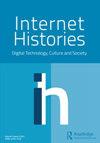Little history of CAPTCHA
IF 1
Q3 COMMUNICATION
引用次数: 5
Abstract
Abstract This article traces the early history of CAPTCHA, the now ubiquitous cybersecurity tool that prompts users to “confirm their humanity” by solving word- and image-based puzzles before accessing free online services. CAPTCHA, and its many derivatives, are presented as content identification mechanisms: the user is asked to identify content in order for the computer to determine the identity of the user. This twofold process of content identification, however, has evolved significantly since CAPTCHA’s inception in the late 1990s. Pivoting away from a realist framework, largely dependent on the standard tenets [of] cryptography, toward a relational framework premised on aesthetic contingency and social consensus, CAPTCHA’s arc uniquely illustrates how contested notions of both “content” and “identity” become materialized in contemporary internet infrastructure. Inspired by Walter Benjamin’s exegetical study of early photography, this critical historicization aims to foreground CAPTCHA as a particularly fraught juncture of humans and computers, which, as with Benjamin’s intervention, productively troubles received ideas of humanism and automation, mediation and materiality.关于验证码的一些历史
本文追溯了CAPTCHA的早期历史,现在无处不在的网络安全工具,在访问免费在线服务之前,通过解决基于文字和图像的谜题,提示用户“确认自己的人性”。CAPTCHA和它的许多衍生产品都是作为内容识别机制呈现的:要求用户识别内容,以便计算机确定用户的身份。然而,自从CAPTCHA在20世纪90年代末出现以来,这种双重的内容识别过程已经发生了重大变化。从现实主义框架(主要依赖于密码学的标准原则)转向以美学偶然性和社会共识为前提的关系框架,CAPTCHA的弧独特地说明了“内容”和“身份”这两个有争议的概念如何在当代互联网基础设施中实现。受到沃尔特·本雅明对早期摄影的训诂研究的启发,这种批判性的历史化旨在将CAPTCHA作为人类和计算机的一个特别令人担忧的接合点,在本雅明的干预下,生产性的麻烦接受了人文主义和自动化、调解和物质性的思想。
本文章由计算机程序翻译,如有差异,请以英文原文为准。
求助全文
约1分钟内获得全文
求助全文

 求助内容:
求助内容: 应助结果提醒方式:
应助结果提醒方式:


